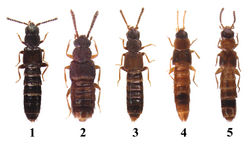Homalota fraterna
| Notice: | This page is derived from the original publication listed below, whose author(s) should always be credited. Further contributors may edit and improve the content of this page and, consequently, need to be credited as well (see page history). Any assessment of factual correctness requires a careful review of the original article as well as of subsequent contributions.
If you are uncertain whether your planned contribution is correct or not, we suggest that you use the associated discussion page instead of editing the page directly. This page should be cited as follows (rationale):
Citation formats to copy and paste
BibTeX: @article{Kim2014ZooKeys, RIS/ Endnote: TY - JOUR Wikipedia/ Citizendium: <ref name="Kim2014ZooKeys">{{Citation See also the citation download page at the journal. |
Ordo: Coleoptera
Familia: Staphylinidae
Genus: Homalota
Name
Homalota fraterna (Sharp, 1888) – Wikispecies link – Pensoft Profile
- Epipeda fraterna Sharp, 1888: 376.
- Homalota fraterna: Fenyes 1914[1]: 46; Fenyes 1918[2]: 87; Smetana 2004[3]: 448.
Specimens examined
KOREA: Chungbuk Prov., Yeongdong-gun, Sangchon-myeon, Mulhan-ri, Mt. Minjujisan, 36°03'35.2"N, 127°52'31.3"E 518 m, 18 V 2011, JG Lee, TK Kim, decaying persimmon (16 exx., 3♂♂, 2♀♀ on slides); Jeonnam Prov., Hadong-gun, Hwahye-myeon, Ssanggyesa, 25 V 2000, K.-J. Ahn, ex under bark (3♀♀); Kangwon Prov., Hoengsunggun, Unduryeng, 9–10 ix 1998, K.-J. Ahn, ex under bark (1♂); Jeju Prov., Seongpanak, 28 IV 1985, KS Lee (3♂♂, 1♀, 1♂ on slide).
Description
Body length 2.3–2.6 mm (Fig. 1). Body dark brown, antennae and legs brown; dorsoventrally flattened, parallel-sided; surface subglossy, slightly pubescent. Head. Subquadrate, almost as wide as pronotum; eyes moderate in size, as long as tempora; infraorbital carina well developed, complete; antennomeres 4–10 transverse, 5–10 slightly incrassate toward apex. Mouthparts. Labrum (Fig. 6) transverse, 7 pairs of macrosetae present, sensilla of antero-medial sensory area shallow and narrowly emarginated, α-sensillum with a setose process, β and γ minute and conical, ε with a short setose process, distinctly shorter than α; two lateral sensilla present on lateral margins of epipharynx, without transverse row of sensory pores on basal region of epipharynx; right mandible (Fig. 7) with small median tooth, prostheca well developed; maxillary palpomere (Fig. 8) 2 and 3 dilated distally, 4 without small spines at apex; labium (Fig. 9) with ligula moderate in length and bifid in its apical half, almost as long as labial palpomere 1, labial palpus with two palpomeres, palpomere 1 almost as long as 2, two medial setae present on prementum, contiguous and one laterally behind the other, median pseudopore field of prementum narrow and with pseudopores, mentum not emarginated in anterior margin. Thorax. Pronotum slightly transverse, about 1.25 times wider than long, widest at apical third, surface pubescent, directed anteriorly in narrow median strip and directed antero-laterally to laterally in lateral area, with some distinct macrosetae, hypomeron broadly visible in lateral aspect; prosternum with a median knob; elytra slightly wider than pronotum, postero-laterally slightly sinuate; mesoventrite (Fig. 10) without longitudinal carina, mesoventral process narrow, apex point; metaventral process round at apex, distinctly shorter than mesoventral process; isthmus present; mesocoxae narrowly separated; tarsomere 1 as long 2, without empodial seta between tarsal claws. Abdomen. Tergites III–VI transversely impressed; tergite X with medial setal patch subquadrate, with transverse row of large spines posteriorly, 4 macrosetae on each side. Genitalia. Spermatheca (Fig. 12) simple and elongate at base; median lobe (Fig. 13) bulbous at base, apical process slender and short with some tubercles, distinctly shorter than basal bulb, flagellum well sclerotized and short; paramere (Fig. 14) with apical lobe of paramerite subcylindrical, with four setae, basal one largest, condylite subequal in length to apex of paramerite. Secondary sexual characteristics. Posterior margin of male tergite VIII (Fig. 11) with two short lateral processes, middle margin broadly round.
Distribution
Korea (South), China (Hainan), Japan, Taiwan.
Remarks
Homalota fraterna is similar to Homalota plana, but can be distinguished by the following features: antennomere 4 transverse, male tergite VII without tubercle, male tergite VIII with short lateral processes; tergite X with medial setal patch subquadrate, with transverse row of large spines posteriorly.
Taxon Treatment
- Kim, Y; Ahn, K; 2014: Taxonomy of the genus Homalota Mannerheim in Korea (Coleoptera, Staphylinidae, Aleocharinae) ZooKeys, (447): 109-123. doi
Images
|
Other References
- ↑ Fenyes A (1914) H. Sauter‘s Formosa–Ausbeute. Aleocharinae. Archiv für Naturgeschichte (A) 80: 45–55.
- ↑ Fenyes A (1918) Coleoptera Fam. Staphylinidae subfam. Aleocharinae. In: Wytsman P (Ed.) Genera Insectorum. Fascicle 173a. Louis Desmet-Verteneuil, Bruxelles, 110 pp.
- ↑ Smetana A (2004) Family Staphylinidae: Aleocharinae. In: Löbl I Smetana A (Eds) Catalogue of Palaearctic Coleoptera Volume 2 Hydrophiloidea-Histeroidea-Staphylinoidea. Apollo Books, Stenstrup, 353–494.


